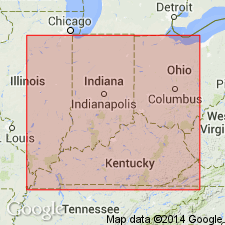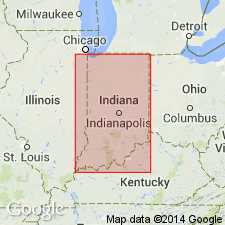
- Usage in publication:
-
- Sellersburg beds
- Modifications:
-
- Named
- Dominant lithology:
-
- Sandstone
- Limestone
- AAPG geologic province:
-
- Cincinnati arch
Summary:
Named Sellersburg beds. "These beds consist of a fine-grained calcareous sandstone from six to twenty feet thick * * *". A thin bed of limestone occurs at top in places. Overlies Jeffersonville limestone; underlies New Albany shale. Age is Devonian.
Source: GNU records (USGS DDS-6; Reston GNULEX).

- Usage in publication:
-
- Sellersburg limestone
- Modifications:
-
- Revised
- AAPG geologic province:
-
- Cincinnati arch
Summary:
Designated Sellersburg limestone. Divided into Silver Creek limestone member and overlying Beechwood limestone member. Silver Creek member is "* * * thick-bedded, dark-gray, fine-grained, low to high magnesian, siliceous and aluminous * * *" limestone. It is moderately fossiliferous, brachiopods and pelecypods being the most common fossils. Thickness ranges from 1.5 to 16 ft. The Beechwood member is "* * * rather thick-bedded. The lower part tends to a light gray color and a fairly coarsely crystalline texture, while the upper part is of finer grain and of dark gray color. It is full of crinoid joints * * *". Thickness probably does not exceed 6 ft. Sellersburg is unconformably underlain by Louisville Limestone; it is overlain by New Albany shale. Age is Middle Devonian.
Source: GNU records (USGS DDS-6; Reston GNULEX).

- Usage in publication:
-
- Sellersburg Limestone
- Modifications:
-
- Not used
- AAPG geologic province:
-
- Cincinnati arch
Summary:
This compendium of rock-unit stratigraphy in Indiana does not list Sellersburg as a stratigraphic name in use in Indiana as of 1970. North Vernon Limestone, which has precedence, is used instead.
Source: GNU records (USGS DDS-6; Reston GNULEX).
For more information, please contact Nancy Stamm, Geologic Names Committee Secretary.
Asterisk (*) indicates published by U.S. Geological Survey authors.
"No current usage" (†) implies that a name has been abandoned or has fallen into disuse. Former usage and, if known, replacement name given in parentheses ( ).
Slash (/) indicates name conflicts with nomenclatural guidelines (CSN, 1933; ACSN, 1961, 1970; NACSN, 1983, 2005, 2021). May be explained within brackets ([ ]).

